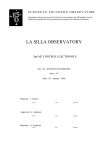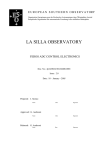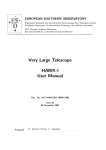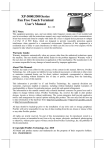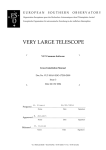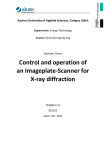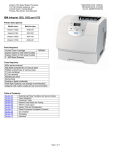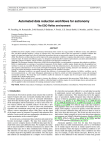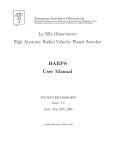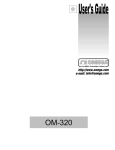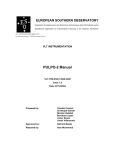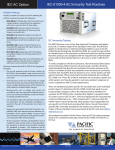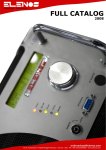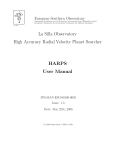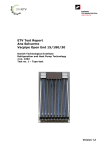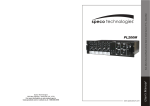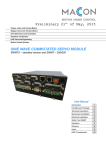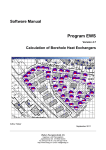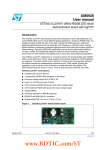Download 3P6-PLA-ESO-60100-00..
Transcript
E U R O P E A N S O U T H E R N O B S E R V A T ORY Organisation Européenne pour des Recherches Astronomiques dans l'Hémisphère Austral Europäische Organisation für astronomische Forschung in der südlichen Hemisphäre LA SILLA-PARANAL OBSERVATORY 3P6 M2 MAINTENANCE PLAN Doc. No.: 3P6-PLA-ESO-60100-0001 Issue: 1.0 Date: 17 – August - 2005 Prepared: J. Alonso Name Date Signature Date Signature Approved: R. Parra Name Released: G. Ihle Name Date Signature Page 2 3P6 M2 MAINTENANCE PLAN 17 - 08 - 2005 Doc. 3P6-PLA-ESO-60100-0001 Plan Document CHANGE RECORD Revision Date Section/Paragraph Remarks Issue 1 17/08/2005 All First Issue Page 3 3P6 M2 MAINTENANCE PLAN 17 - 08 - 2005 Doc. 3P6-PLA-ESO-60100-0001 Plan Document INDEX OF CONTENTS 1. INTRODUCTION .............................................................................................................................5 1.1. 1.2. 1.3. 1.4. 2. M2 OVERVIEW................................................................................................................................7 2.1. 2.2. 3. PURPOSE AND SCOPE.............................................................................................................5 REFERENCE DOCUMENTS.....................................................................................................5 APPLICABLE DOCUMENTS ...................................................................................................5 ACRONYMS & ABBREVIATIONS..........................................................................................6 HISTORY.......................................................................................................................................7 SYSTEM ........................................................................................................................................7 M2 ELECTROMECHANICAL MAINTENANCE TASKS .........................................................8 3.1. FOCUS DRIVE ...............................................................................................................................8 3.1.1. AC Servo Motor...................................................................................................................8 3.1.2. Rotary Encoder..................................................................................................................10 3.1.3. Mitutoyo Linear Encoder...................................................................................................10 3.1.4. Baumer Init/Limit Sensors .................................................................................................11 3.1.5. Catastrophic Limit Sensors ...............................................................................................11 3.2. X DRIVE ....................................................................................................................................12 3.2.1. AC Servo Motor.................................................................................................................12 3.2.2. Rotary Encoder..................................................................................................................14 3.2.3. Baumer Init/Limit Sensors .................................................................................................14 3.2.4. Catastrophic Limit Sensors ...............................................................................................15 3.3. Y DRIVE .....................................................................................................................................15 3.3.1. AC Servo Motor.................................................................................................................15 3.3.2. Rotary Encoder..................................................................................................................17 3.3.3. Baumer Init/Limit Sensors .................................................................................................17 3.3.4. Catastrophic Limit Sensors ...............................................................................................17 4. M2 ELECTRONICS MAINTENANCE TASKS..........................................................................18 4.1. ELECTRONICS CABINET ..............................................................................................................18 4.1.1. Cabinet ..............................................................................................................................18 4.1.2. VME - LCU........................................................................................................................18 4.1.3. VME4SA Voltage Rails Supply ..........................................................................................19 4.1.4. VME Chassis Power Supplies............................................................................................20 4.1.5. Focus Servo Amplifier .......................................................................................................20 4.1.6. X Servo Amplifier ..............................................................................................................21 4.1.7. Y Servo Amplifier...............................................................................................................22 4.2. RACK COOLING ..........................................................................................................................22 4.2.1. VLT Electronic Cabinet Cooling System ...........................................................................22 4.2.2. Safety Thermostat ..............................................................................................................23 5. GLOBAL MAINTENANCE TASKS ............................................................................................24 5.1. 5.2. 6. EXTERNAL INSPECTION ..............................................................................................................24 INTERNAL INSPECTION ...............................................................................................................24 APPENDIX ......................................................................................................................................25 6.1. TOOLS ........................................................................................................................................25 6.1.1. Mitutoyo Encoder Display (MED).....................................................................................25 6.1.2. Encoder Signal Test Box ...................................................................................................26 6.1.3. VME4SA Handset ..............................................................................................................27 6.1.4. DBSC Maintenance Program and PC...............................................................................27 6.1.5. Oscilloscope ......................................................................................................................29 Page 4 3P6 M2 MAINTENANCE PLAN 17 - 08 - 2005 Doc. 3P6-PLA-ESO-60100-0001 Plan Document 6.1.6. Multi-Meter........................................................................................................................29 6.1.7. Hot Wire Thermo-Anemometer .........................................................................................30 6.1.8. X6 and X7 Cables ..............................................................................................................31 6.2. NON STANDARD SPARE PARTS ...................................................................................................32 6.3. 3P6 M2 MAINTENANCE TASKS UNDER REMEDY AND/OR MAXIMO ............................................32 6.4. 3P6 M2 MAINTENANCE FORM ....................................................................................................32 6.5. PICTURES....................................................................................................................................33 INDEX OF FIGURES AND TABLES FIGURE 1 : REFERENCE FOCUS DRIVE CCW CURRENT GRAPH ....................................................................9 FIGURE 2 : REFERENCE FOCUS DRIVE CW CURRENT GRAPH .......................................................................9 FIGURE 3: REFERENCE X DRIVE CCW CURRENT GRAPH ...........................................................................13 FIGURE 4: REFERENCE X DRIVE CW CURRENT GRAPH .............................................................................13 FIGURE 5: REFERENCE Y DRIVE CCW CURRENT GRAPH ...........................................................................16 FIGURE 6: REFERENCE Y DRIVE CW CURRENT GRAPH .............................................................................16 FIGURE 7: MED FRONT PANEL ..................................................................................................................25 FIGURE 8: MED REAR PANEL ....................................................................................................................25 FIGURE 9: MED AC ADAPTER ...................................................................................................................26 FIGURE 10: INCREMENTAL ENCODER OUTPUT SIGNALS.............................................................................26 FIGURE 11: VME4SA HANDSET ................................................................................................................27 FIGURE 12: DBSC PROGRAM MAIN WINDOW............................................................................................28 FIGURE 13: DBSC PROGRAM PLOTTING PHASE CURRENT .........................................................................28 FIGURE 14: DBSC PROGRAM DOING OFFSET TUNING .................................................................................29 FIGURE 15: X6 CABLE ................................................................................................................................31 FIGURE 16 : X7 CABLE ...............................................................................................................................31 FIGURE 17: FOCUS LINEAR ENCODER CONNECTOR ....................................................................................33 FIGURE 18: FOCUS CATASTROPHIC LIMIT SWITCHES .................................................................................33 TABLE 1: VME AUXILIARY POWER SUPPLY TOLERANCE ............................................................................19 TABLE 2: VME POWER SUPPLY TOLERANCE...............................................................................................20 TABLE 3: VME4SA CHANNEL ASSIGNMENT ..............................................................................................27 TABLE 4: ANEMOMETER RANGES AND RESOLUTION ..................................................................................30 TABLE 5 : NON STANDARD SPARE PARTS...................................................................................................32 Page 5 3P6 M2 MAINTENANCE PLAN 17 - 08 - 2005 Doc. 3P6-PLA-ESO-60100-0001 Plan Document 1. INTRODUCTION 1.1. PURPOSE AND SCOPE This document is intended to serve as a maintenance guide-plan for the 3p6 telescope M2 control system, focused on the electronics, electro-optical and electro-mechanical components of the system. The mechanics is briefly covered where relevant and shall be covered somewhere else in detail. Appended to the document you could find useful information for servicing and diagnosing the system together with references to the technical documentation and the newly defined maintenance tasks to be incorporated under Remedy and/or Maximo. 1.2. [RE1] REFERENCE DOCUMENTS 3p6 M2 Control Electronics Doc. No.: 3P6-DSD-ESO-60400-0001 Issue: 2.0 J. Alonso 24 – January - 2005. [RE2] 1.3. APPLICABLE DOCUMENTS [AP1] ESO VME4SA-X1 4-Channel DC Servo Amplifier Technical Manual VLTMAN-ESO-17130-0273 Issue 3.0. [AP2] ESO VME4SA BACKPLANE Technical Manual VLT-MAN-ESO-171300274 Issue 3.0. [AP3] VLT Electronic Cabinet Cooling System User Manual VLT-MAN-ESO17130-1603 Issue 1.0 F. Biancat Marchet April 27, 1998. [AP4] USER-Manual MACCONTROLLER MAC4-INC Version 4.2. [AP5] Harmonic Drive Operations Manual AC-Servo Amplifier SC-500/510. [AP6] Page 6 3P6 M2 MAINTENANCE PLAN 17 - 08 - 2005 Doc. 3P6-PLA-ESO-60100-0001 Plan Document 1.4. AC DC DBSC VME LCU PPR PC UL LL HARPS BW TBD ELC MED N/A N/U ACRONYMS & ABBREVIATIONS Alternating Current Direct Current Digital Brushless Servo Control software Versa Module Europe Local Control Unit Pulse Per Revolution Personal Computer Upper Limit Lower Limit High Accuracy Radial Velocity Planetary Search Band Width To Be Defined Electronics Mitutoyo Encoder Display Not Available Not Used Page 7 3P6 M2 MAINTENANCE PLAN Plan Document 2. 17 - 08 - 2005 Doc. 3P6-PLA-ESO-60100-0001 M2 OVERVIEW 2.1. History Since ever the 3.6 telescope f/8 secondary unit has suffered from considerable mechanical instabilities. This together with the inability to introduce online corrections to the decentring comma has severely limited the optical performance of the telescope. Considering that the new generation of instruments (e.g. HARPS) need to exploit the maximum possible optical image quality attainable with the telescope, a new mechanical design based on the NTT secondary unit concept was designed and built. The new M2 unit is equipped with VLT complaint computer controlled servo drives for the focus, X and Y motions of the secondary mirror unit. The unit was commissioned during September/August 2004 and is successfully operating since them. This zero failure 1 year period was the base criteria for defining the frequency of the various maintenance tasks. 2.2. System The motion control electronic components used for the M2 are: ¾ MACC4/INC [AP4] and VME-4SA [AP1] VME VLT standard modules. ¾ Harmonic Drive AC-Servo Amplifier SC500/510 [AP5] Three Harmonic Drive Systems servo actuators type FHA-25B-3015E-E150 are used for rotating the focus, X and Y driving screws. These actuators integrate a brushless AC motor together with a harmonic reduction gear and an incremental 1500 PPR optical shaft encoder coupled to the motor axis. Each linear drive is complemented by end of stroke high precision limit/init switches together with coarse catastrophic-limit switches. Every actuator is accompanied by three screw terminals group. All the connections from the actuator and limit/init switches are routed trough these terminals to the control LCU-power amplifiers cabinet. The signal groups correspond to; AC motor drive, incremental encoder and limit/init switches. The control electronics is mounted on top of the M2 unit inside a hermetically sealed Knürr cabinet equipped with an active heat exchanger unit. The cabinet houses a VME LCU, three AC servo amplifiers and support circuitry. Externally the control cabinet receives only; the mains 220VAC power supply, the Ethernet connection, one inlet and one outlet coolant hoses. By opening the rear door an external PC could be connected via RS232 to each AC servo amplifier and to the LCU console port. This is for setup and engineering monitoring and maintenance of the servo amplifiers and VME CPU configuration. From the control cabinet three identical groups of signals are routed to its close neighbour the M2 drive. Page 8 3P6 M2 MAINTENANCE PLAN 17 - 08 - 2005 Doc. 3P6-PLA-ESO-60100-0001 Plan Document 3. M2 ELECTROMECHANICAL MAINTENANCE TASKS 3.1. Focus Drive 3.1.1. AC Servo Motor Description: Acoustical and visual servomotor inspection and phase current consumption measurement. Actions: Bring the telescope to the platform position, do the inspections and measurements at the platform. Visual inspection; check for external deterioration of the motor housing and specially the cables passing into the motor via the two metallic cable feed-troughs. Acoustical inspection; Drive the servo motor by using the VME4SA handset (refer to 6.1.3 for details) and closely listen to the sound produced by the whole focus drive mechanism. Under normal circumstances the sound is low level and, most important, single pitched. Connect the laptop PC to the focus servo amplifier serial port connector X6 and perform the phase current measurement. Drive the servo motor by using the DBSC Harmonic Drive program (refer to 6.1.4 for details). Acquire CCW and CW graphs and compare them with the reference graphs shown below. Be sure that the peak currents are within the ranges marked on the reference graphs. Fill in the pertinent section of the 3p6 M2 maintenance form and add comments if anomalies are found. Frequency: Once every year. Caveats: You should acquire graphs similar to the reference ones shown below. The peak current value of both phases shall be within the margins marked on the reference graphs as upper and lower limit. Note that the envelope in the curve represents the instantaneous current fluctuations due to the mechanical eccentricities of the motor/screw combination. Therefore the amplitude of the envelope shall normally lie within 0.2 Amperes peak-peak, and by itself is a powerful tool for diagnosing and/or predicting mechanical problems. Page 9 3P6 M2 MAINTENANCE PLAN Plan Document CAUTION: 17 - 08 - 2005 Doc. 3P6-PLA-ESO-60100-0001 Be aware that the serial port buffers at the servo amplifier are electrically fragile. So preferably use the laptop unplugged from the mains when doing the measurements. Or if not possible be sure to plug it to the spare 220V outlet available inside the M2 electronics cabinet. Figure 1 : Reference Focus Drive CCW Current Graph Figure 2 : Reference Focus Drive CW Current Graph Page 10 3P6 M2 MAINTENANCE PLAN 17 - 08 - 2005 Doc. 3P6-PLA-ESO-60100-0001 Plan Document 3.1.2. Rotary Encoder Description: Encoder signals test/inspection. Actions: Use the encoder signal test box (refer to 6.1.2 for test box usage details) and the X7 adapter cable (refer to 6.1.8 for X7 cable details). Connect the test box to the X7 connector of the focus servo amplifier and inspect the signal outputs with an oscilloscope (settings: channels 1 & 2 at 2V/div, time base 5µS, normal trigger channel 1 at 1.8V triggering level). With the aid of the VME4SA handset (refer to 6.1.3 for handset details) drive the axis at the highest possible speed. While moving measure the amplitude and 90º phase difference of the signals and compare them with the reference in Figure 10 section 6.1.2. Fill in the pertinent section of the 3p6 M2 maintenance form and add comments if anomalies are found. Frequency: Once every year. Caveats: The focus drive utilizes the rotary encoder signals only for velocity feedback. Therefore the X7 connector at the focus servo amplifier remains unused during normal operation. X7 output is used only during this particular test/inspection. Position feedback in this axis is provided by an independent linear encoder. 3.1.3. Mitutoyo Linear Encoder Description: Linear encoder functionality test/inspection. Actions: Using the encoder signal test box (refer to 6.1.2 for the test box details) and the VME4SA handset (refer to 6.1.3 for the handset details) test the encoder functionality. Disconnect the linear encoder from the system (at the patch box labelled “FOCUS” see Figure 17 ) and connect it to the encoder test box. With the aid of the VME4SA handset drive the axis at the highest possible speed. While moving measure with an oscilloscope (settings: channels 1 & 2 at 2V/div, time base 2mS, normal trigger channel 1 at 1.8V triggering level) the amplitude and 90º phase difference of the signals and compare them with the reference in Figure 10 section 6.1.2. Page 11 3P6 M2 MAINTENANCE PLAN 17 - 08 - 2005 Doc. 3P6-PLA-ESO-60100-0001 Plan Document Fill in the pertinent section of the 3p6 M2 maintenance form and add comments if anomalies are found. Frequency: Once every year. Caveats: After removing the display box reconnect everything properly adjusting in place the bayonet fixation of the connector. 3.1.4. Baumer Init/Limit Sensors Description: Check the functionality and repeatability of the Init/Limit sensors. Actions: Using the VME4SA handset (refer to 6.1.3 for the handset details) and the MED (refer to 6.1.1 for MED details) test the Init/Limit sensors. Disconnect the linear encoder from the system (at the patch box labelled “FOCUS”) and connect it to the MED. With the handset move the axis toward each limit (UL and LL) and, once reaching the particular limit, press the zero button of the display box. Go out of the limit and come back, this time don’t zero the display box. When back on limit the readout must be ideally 0 in practice shall be within ~ +/-2 counts. Fill in the pertinent section of the 3p6 M2 maintenance form and add comments if anomalies are found. Frequency: Once every year. Caveats: For the focus drive 1 count of the MED corresponds to 1µm of axis displacement. (1 count is the unitary increment or decrement of the right most display digit). After removing the display box reconnect everything properly adjusting in place the bayonet fixation of the connector. 3.1.5. Catastrophic Limit Sensors Description: Check the functionality of the catastrophic Limit sensors. Actions: Using the VME4SA handset (refer to 6.1.3 for the handset details) drive the axis to the UL and LL. Page 12 3P6 M2 MAINTENANCE PLAN 17 - 08 - 2005 Doc. 3P6-PLA-ESO-60100-0001 Plan Document Once on each limit insert a 0.5mm thickness blade in between the Omron D4D-1532N limit switch actuation wheel and the carriage itself. The complete rack shall be de-energized at the 220V mains supply level when the blade is inserted. Wait ten seconds and remove the blade the power must be re-established. Fill in the pertinent section of the 3p6 M2 maintenance form and add comments if anomalies are found. Frequency: Once every two years. Caveats: Be aware that this test de-energize the whole rack and is intended for ultimate protection only. During normal operation this limit will never be activated, therefore when doing the test try to insert and remove the blade effectively avoiding multiple on and offs of the system, this is to minimize possible harmful transients. 3.2. X Drive 3.2.1. AC Servo Motor Description: Acoustical and visual servomotor inspection and phase current consumption measurement. Actions: For X drive, follow the same steps as on 3.1.1. Of course this time connect the laptop to the X servo amplifier serial port connector X6. Frequency: Once every year. Caveats: You should acquire graphs similar to the reference ones shown below. The peak current value of both phases shall be within the margins marked on the reference graphs as upper and lower limit. Note that the envelope in the curve represents the instantaneous current fluctuations due to the mechanical eccentricities of the motor/screw combination. Therefore the amplitude of the envelope shall normally lie within 0.5 Amperes peak-peak, and by itself is a powerful tool for diagnosing mechanical problems. Note that for the X drive the current consumption is significantly higher than for the focus drive. This is mainly due to the fact that the X mechanism is not counter balanced, very heavily preloaded and no flexion couplings are used between the motor and the screw. Page 13 3P6 M2 MAINTENANCE PLAN Plan Document CAUTION: 17 - 08 - 2005 Doc. 3P6-PLA-ESO-60100-0001 Be aware that the serial port buffers at the servo amplifier are electrically fragile. So preferably use the laptop unplugged from the mains when doing the measurements. Or if not possible be sure to plug it to the spare 220V outlet available inside the M2 electronics cabinet. Figure 3: Reference X Drive CCW Current Graph Figure 4: Reference X Drive CW Current Graph Page 14 3P6 M2 MAINTENANCE PLAN 17 - 08 - 2005 Doc. 3P6-PLA-ESO-60100-0001 Plan Document 3.2.2. Rotary Encoder Description: Encoder signals test/inspection. Actions: Follow the same procedure as on 3.1.2 and fill in the pertinent section of the 3p6 M2 maintenance form, additionally add comments if anomalies are found. Frequency: Once every year. Caveats: The X drive utilizes the rotary encoder signals both for velocity and position feedback. Therefore the X7 connector at the X servo amplifier must be unplugged for performing the test. This is to allow the X7 cable to be plugged. To resume normal operation be sure to reconnect the original cable at X7. Be sure to secure the connector properly in place without over tightening the screw fixations. 3.2.3. Baumer Init/Limit Sensors Description: Check the functionality and repeatability of the Init/Limit sensors. Actions: Using the VME4SA handset (refer to 6.1.3 for the handset details) and the MED Display (refer to 6.1.1 for the MED details) test the Init/Limit sensors. Disconnect the X7 encoder connector at the X servo amplifier and by the aid of the X7 cable connect the MED to the X7 connector of the X amplifier. Move the axis toward each limit (UL and LL). When performing this test due to the extremely high resolution (resolution not precision and stability) of the axis you should bias the axis momentarily using the DBSC program. This is to allow a stable readout. When doing the LL use +20mV offset and for the UL use -20mV offset. Be sure to re-establish the original value when finishing. For testing, after setting the proper bias, move the axis toward the limit, while stop on limit press the zero button of the display box. Go out of the limit and come back to the limit, this time don’t zero the display box. When back on limit the readout must be ideally 0 in practice shall be within ~ +/-1200 counts. Fill in the pertinent section of the 3p6 M2 maintenance form and add comments if anomalies are found. Frequency: Once every year. Page 15 3P6 M2 MAINTENANCE PLAN 17 - 08 - 2005 Doc. 3P6-PLA-ESO-60100-0001 Plan Document Caveats: For the X drive 1 count of the MED corresponds to 0.0016µm resolution (not precision). One count is the unitary increment or decrement of the right most display digit. To resume normal operation be sure to reconnect the original cable at X7 and do not forget to re-establish the proper offset. Secure the connector properly in place without over tightening the screw fixations. 3.2.4. Catastrophic Limit Sensors Description: Check the functionality of the catastrophic Limit sensors. Actions: Same as on 3.1.5. Frequency: Once every two years. Caveats: Same as on 3.1.5. 3.3. Y Drive 3.3.1. AC Servo Motor Description: Acoustical and visual servomotor inspection and phase current consumption measurement. Actions: For Y drive, follow the same steps as on 3.1.1. Of course this time connect the laptop to the Y servo amplifier serial port connector X6. Frequency: Once every year. Caveats: You should acquire graphs similar to the reference ones shown below. The peak current value of both phases shall be within the margins marked on the reference graphs as upper and lower limit. Note that the envelope in the curve represents the instantaneous current fluctuations due to the mechanical eccentricities of the motor/screw combination. Therefore the amplitude of the envelope shall normally lie within 0.5 Amperes peak-peak, and by itself is a powerful tool for diagnosing mechanical problems. Note that for the Y drive the current consumption is significantly higher than for the focus drive. This is mainly due to the fact that the Y mechanism is not counter balanced, very heavily preloaded and no flexion couplings are used between the motor and the screw. Page 16 3P6 M2 MAINTENANCE PLAN Plan Document CAUTION: 17 - 08 - 2005 Doc. 3P6-PLA-ESO-60100-0001 Be aware that the serial port buffers at the servo amplifier are electrically fragile. So preferably use the laptop unplugged from the mains when doing the measurements. Or if not possible be sure to plug it to the spare 220V outlet available inside the M2 electronics cabinet. Figure 5: Reference Y Drive CCW Current Graph Figure 6: Reference Y Drive CW Current Graph Page 17 3P6 M2 MAINTENANCE PLAN 17 - 08 - 2005 Doc. 3P6-PLA-ESO-60100-0001 Plan Document 3.3.2. Rotary Encoder Description: Encoder signals test/inspection. Actions: Follow the same procedure as on 3.1.2 and fill in the pertinent section of the 3p6 M2 maintenance form additionally add comments if anomalies are found. Frequency: Once every year. Caveats: Same as on 3.2.2 if X is replaced by Y. 3.3.3. Baumer Init/Limit Sensors Description: Check the functionality and repeatability of the Init/Limit sensors. Actions: Same as on 3.2.3 if X is replaced by Y. Fill in the pertinent section of the 3p6 M2 maintenance form and add comments if anomalies are found. Frequency: Once every year. Caveats: Same as on 3.2.3. 3.3.4. Catastrophic Limit Sensors Description: Check the functionality of the catastrophic Limit sensors. Actions: Same as on 3.1.5. Frequency: Once every two years. Caveats: Same as on 3.1.5. Page 18 3P6 M2 MAINTENANCE PLAN 17 - 08 - 2005 Doc. 3P6-PLA-ESO-60100-0001 Plan Document 4. M2 ELECTRONICS MAINTENANCE TASKS 4.1. Electronics Cabinet 4.1.1. Cabinet Description: Cabinet tightness inspection and general mechanical condition. Actions: 1- Inspect for proper adjustment and sealing of the front and back doors. 2- Check the condition of the doors gaskets, both the rubber and metallic ones. 3- Check the cables feed-trough for proper tightness, with the aid of a flashlight illuminate from the opposite side you are looking. 4- Check for condensation inside the cabinet. Fill in the pertinent section of the 3p6 M2 maintenance form and add comments if anomalies are found. Frequency: Once every year. Caveats: The cabinet is a KNÜRR “Pro-Rack” type. These cabinets are hermetically sealed mechanically, thermally and electrically. When opening and closing be sure that the door’s gaskets are properly seated, if necessary push the door not only from the lock. 4.1.2. VME - LCU Description: VME bus contact cleaning, VME boards dust off, fans checkout, air ducts and/or internal surfaces dust off. Actions: 1- Remove the VME modules and dust off the modules by blowing air onto them. 2- Clean the contacts of connectors P1 and P2 with oil free contact cleaner. 3- Inspect for bended or loose pins. 4- Dust off the fans and check them acoustically, normally they should produce a single pitched sound. 5- Dust off the air ducts and/or internal surfaces. 6- Measure the air flow by the aid of a “Hot Wire ThermoAnemometer” (refer to 6.1.7 for the usage of the anemometer). For inserting the anemometers prove temporarily remove the Page 19 3P6 M2 MAINTENANCE PLAN 17 - 08 - 2005 Doc. 3P6-PLA-ESO-60100-0001 Plan Document blind plates of the front panel. Ideally the air flow measurement shall be made near the VME board component side. The air speed shall be 0.5m/sec -10% maximum. Fill in the pertinent section of the 3p6 M2 maintenance form and add comments if anomalies are found. Frequency: Once every year. Caveats: From left to right the VME modules and power supplies are: 1) MVME 2604 Power PC 604 32MB RAM - CPU. 2) MAC-INC Servo control module. 3) VME4SA-I DC Servo amplifier module. 4) VME Multi-voltage DC power supply. 5) Stacked 15 volts power supplies. Exercise special care when unplugging and plugging back the VME modules. Always be sure that the modules are sliding properly over the insertion rails and after, for insertion, apply and even force at the top and bottom of the module’s front panel. Fail to observe these precautions could result in malfunction and/or connector’s pin damage. 4.1.3. VME4SA Voltage Rails Supply Description: VME auxiliary power supplies checkout. Actions: Measure the DC and AC noise voltage of the VME power supplies. Use a multi-meter and a 20 Mhz bandwidth oscilloscope. The voltage and noise values shall be: Nominal Volts Tolerance Volts +15 -15 +0.750 / -0.450 -0.750 / +0.450 Noise (20Mhz BW) Volts Peak-Peak max. 0.1 0.1 Table 1: VME auxiliary power supply tolerance Fill in the pertinent section of the 3p6 M2 maintenance form and add comments if anomalies are found. Frequency: Once every year. Page 20 3P6 M2 MAINTENANCE PLAN 17 - 08 - 2005 Doc. 3P6-PLA-ESO-60100-0001 Plan Document Caveats: For measuring use the power supply’s front panel test points. The voltage noise level is specified for 20 Mhz bandwidth. 4.1.4. VME Chassis Power Supplies Description: VME power supplies checkout. Actions: Measure the DC and AC noise voltage of the VME power supplies. Use a multi-meter and a 20 Mhz bandwidth oscilloscope. The voltage and noise values shall be: Nominal Volts Tolerance Volts +5 +12 -12 +0.250 / -0.125 +0.600 / -0.360 -0.600 / +0.360 Noise (20Mhz BW) Volts Peak-Peak max. 0.1 0.1 0.1 Table 2: VME power supply tolerance Fill in the pertinent section of the 3p6 M2 maintenance form and add comments if anomalies are found. Frequency: Once every year. Caveats: For measuring use the power supply’s front panel test points. The voltage noise level is specified for 20 Mhz bandwidth. 4.1.5. Focus Servo Amplifier Description: Visual inspection, velocity loop DC offset tuning and DC offset monitoring. Actions: Use the Mitutoyo display, DBSC maintenance PC, VME4SA handset and the X7 adapter cable (refer to section 6.1 for details on these tools). Turn of the external mains power switch (red rotary knob at the rack side) and disconnect the CPU module. Connect the handset to the VME4SA. Connect the MED and the DBSC PC to the servo amplifier. Turn on the mains power, at this point and since the system has no CPU the position loop will be disable and you will gain direct control of the velocity loop via the handset and the PC. Page 21 3P6 M2 MAINTENANCE PLAN 17 - 08 - 2005 Doc. 3P6-PLA-ESO-60100-0001 Plan Document Monitoring the DC offset stability. Connect the display to the servo amplifier and with the handset move the axis in both directions at low speed several times. Once you release the handset switch the display readout must stop moving in a couple of seconds and remain with slight right most digit variations. If when releasing the switch the axis continues drifting appreciably (>10 counts per second), adjust the offset (refer to 6.1.4 for detailed procedure). Visually inspect the amplifier checking all the screw terminal connections to be adequately tightened and the cables coming to the amplifier not stressed. Fill in the pertinent section of the 3p6 M2 maintenance form and add comments if anomalies are found. Frequency: Once every two years. Caveats: The velocity loop of each axis (Focus, X, Y) is closed inside the servo amplifier itself and the command signal is an analogue voltage coming from the VME4SA-1. Since the velocity loop is nested inside a digital position loop the drift due to voltage offset is compensated by the “outer” position loop and during normal operation is invisible. However, a minimized and stable DC offset is important to maximize the dynamic range of the control system, and by itself is and indication of the health of the amplifier. A voltage offset lurking around like a drunken sailor does not inspire confidence and shall be investigated. CAUTION: Potentially hazardous voltages are present at some servo amplifier’s screw terminals. 4.1.6. X Servo Amplifier Description: Visual inspection, velocity loop DC offset tuning and DC offset monitoring. Actions: Same as on 4.1.5. Frequency: Once every two years. Caveats: Same as on 4.1.5. CAUTION: Potentially hazardous voltages are present at some servo amplifier’s screw terminals. Page 22 3P6 M2 MAINTENANCE PLAN 17 - 08 - 2005 Doc. 3P6-PLA-ESO-60100-0001 Plan Document 4.1.7. Y Servo Amplifier Description: Visual inspection, velocity loop DC offset tuning and DC offset monitoring. Actions: Same as on 4.1.5. Frequency: Once every two years. Caveats: Same as on 4.1.5. CAUTION: Potentially hazardous voltages are present at some servo amplifier’s screw terminals. 4.2. Rack Cooling 4.2.1. VLT Electronic Cabinet Cooling System Description: Check the cooling system functionality, measure the air velocity at the fans. Actions: Repeatedly press the downward arrow labelled pushbutton at the unit’s front panel. You will step trough 4 indications: 1- Mode: local 2- Controller Status: active 3- Tinlet: 0.9ºC - Toutlet: 6.4ºC 4- Ambient temp: 8.6ºC - Cabinet temp 8.4ºC Measure the air velocity at each of the four fan outlets. Use the thermo-anemometer. Air velocity reference value = 0.5m/Sec 10% maximum. Acoustically inspect the fans they should produce an even single pitched sound. Fill in the pertinent section of the 3p6 M2 maintenance form and add comments if anomalies are found. Frequency: Once every six month. Page 23 3P6 M2 MAINTENANCE PLAN 17 - 08 - 2005 Doc. 3P6-PLA-ESO-60100-0001 Plan Document Caveats: The main function of the Electronic cabinet cooling system is to extract the heat of the rack but, at the same time, keep the internal temperature almost identical to the ambient. This is important to avoid thermal gradients that could deteriorate the seeing of the telescope. The temperature values above presented are only a reference and of course will vary accordingly with the ambient temperature. 4.2.2. Safety Thermostat Description: Check the thermostat setting and functionality. Actions: Dial setting 30ºC. Aim a hot air gun from a distance of ~50 cm and put a handheld thermometer prove touching the thermostat case. Heat up the thermostat using the minimum power setting of the gun until it trips of. Monitor the hot air temperature while testing. Fill in the pertinent section of the 3p6 M2 maintenance form and add comments if anomalies are found. Frequency: Once every two years. Caveats: Be aware that this test de-energize the whole rack and is intended for ultimate protection only. During normal operation this thermostat will never be activated, therefore when doing the test try to be effective and avoid multiple on and offs of the system, this is to minimize possible harmful transients. Page 24 3P6 M2 MAINTENANCE PLAN 17 - 08 - 2005 Doc. 3P6-PLA-ESO-60100-0001 Plan Document 5. GLOBAL MAINTENANCE TASKS 5.1. External Inspection Description: Inspection of the overall system externally (electronic rack and mechanism itself). Actions: Check: 1- Rack mechanical fixations to the M2 structure. 2- Cable fixations and layout. 3- Forgotten tools or loose components. 4- Water leaks from the coolant hoses. 5- Loose gaskets and/or below protections. Fill in the pertinent section of the 3p6 M2 maintenance form and add comments if anomalies are found. Frequency: Once every six months. Caveats: N/A 5.2. Internal Inspection Description: Inspection of the overall system internally (Components inside the rack such as amplifiers, VME chassis, DIN rail mounted components, etc). Actions: Check: 1- Loose components inside the rack. 2- Loose screw terminals. 3- Cable fixations and layout. 4- Forgotten tools. 5- Water leaks from the coolant hoses. Fill in the pertinent section of the 3p6 M2 maintenance form and add comments if anomalies are found. Frequency: Once every six months. Caveats: N/A Page 25 3P6 M2 MAINTENANCE PLAN 17 - 08 - 2005 Doc. 3P6-PLA-ESO-60100-0001 Plan Document 6. APPENDIX 6.1. Tools 6.1.1. Mitutoyo Encoder Display (MED) The MED is an encoder counter box specifically designed for Mitutoyo linear encoders. When used with Mitutoyo linear encoders the least significant digit value corresponds to 1µm (right most digit) provided that the “units” and “diameter” switches at the rear panel are set to “mm” and “off” respectively. The direction switch affects the counting direction only and can be set as desire. The only relevant front panel buttons for our test are; the green power switch and the yellow zero push button. In our test application we will use the MED with two encoder types; the linear Mitutoyo and the rotary encoders inside the M2 servo-motors or harmonic drives. The count to M2 axis linear displacement equivalence is; for the linear encoder 1µm and for the rotary encoder 0.0016µm resolution (for both cases the precision is around 2µm). The MED was modified for monitoring with a single ended oscilloscope probe differential encoder signals. Two banana receptacles named PH1 and PH2 carry the encoder phases referenced to the binding post ground, see Figure 8. Figure 7: MED Front Panel Figure 8: MED Rear Panel Page 26 3P6 M2 MAINTENANCE PLAN 17 - 08 - 2005 Doc. 3P6-PLA-ESO-60100-0001 Plan Document Figure 9: MED AC Adapter The MED is powered by the aid of an external AC adapter see Figure 9. 6.1.2. Encoder Signal Test Box The encoder signal test box is the same unit described on 6.1.1. On the rear panel this unit has three test points label GND, PH1 and PH2 where you should connect your oscilloscope probes for testing (note that this is a custom modification not a Mitutoyo standard feature. Refer to 6.1.1). Figure 10: Incremental Encoder Output Signals The phase difference between A and B signals must be 90º +/- 15%. Page 27 3P6 M2 MAINTENANCE PLAN 17 - 08 - 2005 Doc. 3P6-PLA-ESO-60100-0001 Plan Document 6.1.3. VME4SA Handset The handset is plugged in the front panel of the VME4SA and used for manually driving the velocity servo loops. During normal operation of the system the handset function is disabled by software. Therefore for activating the handset function it is necessary to either; reset the CPU and not allow bootstrap or turn off the power of the system remove the CPU and turn on again. Figure 11: VME4SA Handset VME4SA Channel I II III IV M2 Axis Y X FOCUS N/U Table 3: VME4SA channel assignment 6.1.4. DBSC Maintenance Program and PC As previously mentioned in this document the M2 servo amplifiers implement many features including; velocity loop, over temperature protection, limit switches inputs for disabling the axis etc. The velocity reference to the amplifier is an analogue signal and the velocity feedback is obtained from a 1500 PPR rotary encoder directly coupled to the AC motor axis. All these functions are managed by a flash memory equipped microprocessor inside the servo amplifier. This microprocessor communicates via RS232 with a Windows program (provided by the manufacturer) for parameter setting, parameter tuning, diagnosing, testing, etc. During normal operation the settings remain inside the flash memory of the amplifier and the RS232 link with the PC is not necessary. This program is currently installed in a notebook and is available for M2 maintenance. Since the program is under MS Windows is self-explanatory well documented and easy to use. We will use it mainly for phase current acquisition and offset tuning. Below you can see two typical screens of the program. In any event we will exercise the program in the laboratory with a mock-up of one M2 axis before using it in the field. Page 28 3P6 M2 MAINTENANCE PLAN Plan Document 17 - 08 - 2005 Doc. 3P6-PLA-ESO-60100-0001 Figure 12: DBSC Program Main Window Figure 13: DBSC Program Plotting Phase Current Page 29 3P6 M2 MAINTENANCE PLAN Plan Document 17 - 08 - 2005 Doc. 3P6-PLA-ESO-60100-0001 Figure 14: DBSC Program doing offset tuning 6.1.5. Oscilloscope Fluke type 199C “Scope-meter Colour” or equivalent. (This particular oscilloscope includes multi-meter). If necessary refer to instrument’s manual for operating instructions. 6.1.6. Multi-Meter Fluke 85 III True RMS multi-meter or equivalent. If necessary refer to instrument’s manual for operating instructions. Page 30 3P6 M2 MAINTENANCE PLAN 17 - 08 - 2005 Doc. 3P6-PLA-ESO-60100-0001 Plan Document 6.1.7. Hot Wire Thermo-Anemometer EXTECH407123. Hot wire thermo-anemometer. This is a digital handheld instrument with a probe for measuring air speed. The specifications are as follows: Display type = 2000 counts LCD. Basic accuracy = +/-3%. Probe diameter = 1.3cm (telescopic). Units Ft/min m/sec Km/hr MPH Knots Range (resolution) 40 to 3940 (10) 0.2 to 20 (0.1) 0.7 to 72.0 (0.1) 0.5 to 45.0 (0.1) 1.0 to 31.0 (0.1) Table 4: Anemometer Ranges and Resolution If necessary refer to instrument’s manual for operating instructions. Page 31 3P6 M2 MAINTENANCE PLAN 17 - 08 - 2005 Doc. 3P6-PLA-ESO-60100-0001 Plan Document 6.1.8. X6 and X7 Cables The X6 cable is a standard RS232 null modem (pins 2 and 3 crossed) Dsub9 male to Dsub9 female 4 meters length. The cable is used for connecting the DBSC PC to the servo amplifier under test. Figure 15: X6 Cable The X7 cable is a special, two meter length, twisted pair cable equipped with Dsub9 male connector on one side and on the other a 6 pin Hirose connector (Mitutoyo standard). The cable is used for monitoring the rotary encoder signals with the Mitutoyo encoder display. Figure 16 : X7 Cable Page 32 3P6 M2 MAINTENANCE PLAN 17 - 08 - 2005 Doc. 3P6-PLA-ESO-60100-0001 Plan Document 6.2. Non Standard Spare Parts Most of the spare parts needed for the M2 system are standard VLT components. The list below includes mostly non standard special parts. Item 1 2 3 4 5 6 Description Harmonic Drive Servo Amplifier SC-510 MVME712 VME CPU transition module (standard item) KNIEL TYP> CP 15.1,6 power supply AC Servo Armonic Drive Actuator FHA-25B (with brake) Line Filter Schaffner FN350-8-29 3.6 M2 Limit Switches Signal Conditioner Module Qty 1 1 1 1 2 1 Table 5 : Non Standard Spare Parts 6.3. 3p6 M2 Maintenance Tasks Under Remedy and/or Maximo TBD and agreed by the ELC team. 6.4. 3p6 M2 Maintenance Form TBD and agreed by the ELC team. Page 33 3P6 M2 MAINTENANCE PLAN 17 - 08 - 2005 Doc. 3P6-PLA-ESO-60100-0001 Plan Document 6.5. Pictures Figure 17: Focus Linear Encoder Connector Figure 18: Focus Catastrophic Limit Switches


































